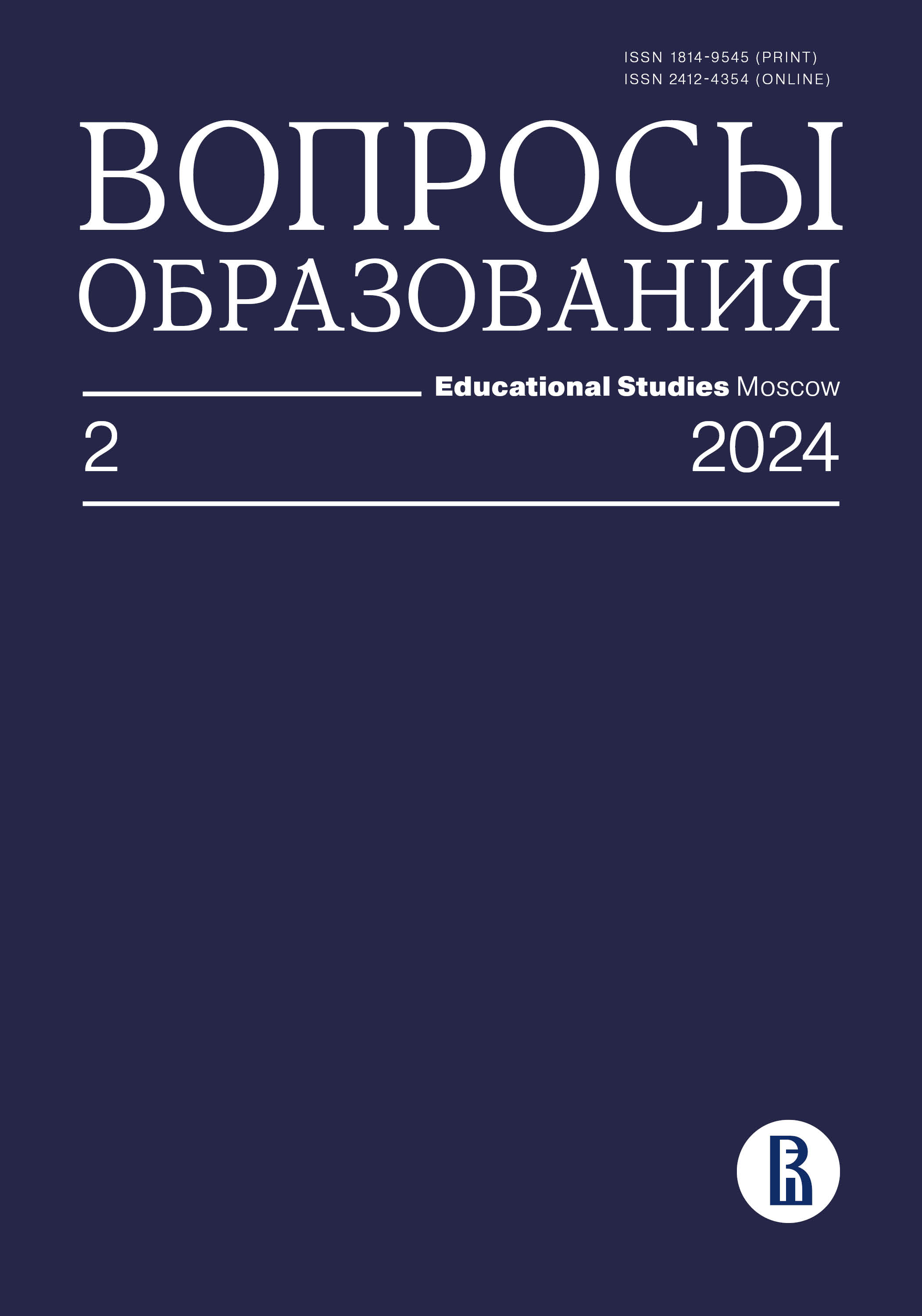Critical Thinking Dispositions: Development and Validation of an Assessment Tool
Abstract
The article describes the process of developing and testing the “Critical Thinking Dispositions” (CDT) tool. Critical thinking dispositions refer to a person's predispositions, tendencies, or readiness to implement critical thinking skills. The relevance of studying and measuring CDT is reflected in the relationship of the construct with the psychological characteristics of a person and his success in various fields. Also, dispositions are important for the manifestation of critical thinking skills: a person with low dispositions may not demonstrate critical thinking, even if it is expressed at a high level. Currently, there is a lack of validated Russian-language instruments dedicated to CDT. The purpose of the study was to develop a CDT instrument and test its validity. Descriptions of the construct in the research literature, analysis of existing theoretical frameworks, and tools for measuring critical thinking dispositions are provided. The instrument is a self-report questionnaire in computer format. The respondent’s task is to assess how similar his behavior in everyday life is to that described in the statements. The questionnaire was tested, based on the data obtained, the factor structure and the quality of the developed tasks were checked, and convergent and content validity was assessed. The results of psychometric testing suggest that the developed instrument is a reliable and valid way to assess critical thinking dispositions in Russian-speaking people over 16 years of age. Limitations of this study and possible directions for future developments are discussed.
Downloads
References
Chaung S.K. (2011) Critical Thinking Disposition, Problem Solving Ability, and Clinical Competence in Nursing Students. Journal of Korean Academy of Fundamentals of Nursing, vol. 18, no 1, pp. 71–78.
Choi H.R., Cho D.S. (2011) Influence of Nurses' Performance with Critical Thinking and Problem Solving Process. Korean Journal of Women Health Nursing, vol. 17, no 3, pp. 265–274. http://dx.doi.org/10.4069/kjwhn.2011.17.3.265
Clifford J.S., Boufal M.M., Kurtz J.E. (2004) Personality Traits and Critical Thinking Skills in College Students: Empirical Tests of a Two-Factor Theory. Assessment, vol. 11, no 2, pp. 169–176. http://dx.doi.org/10.1177/1073191104263250
Edman K.W. (2009) Exploring Overlaps and Differences in Service-Dominant Logic and Design Thinking. Paper presented at 1st Nordic Conference on Service Design and Service Innovation (Oslo, 2009, 24–26 November).
El-Sayed R.S., Sleem W.F., El-Sayed N.M., Ramada F.A. (2011) Disposition of Staff Nurses’ Critical Thinking and Its Relation to Quality of Their Performance at Mansoura University Hospital. Journal of American Science, vol. 7, no 10, pp. 388–395.
Ennis R.H. (1996) Critical Thinking Dispositions: Their Nature and Assessability. Informal Logic, vol. 18, no 2, pp. 165–182. https://doi.org/10.22329/il.v18i2.2378
Ennis R.H. (1993) Critical Thinking Assessment. Theory into Practice, vol. 32, no 3, pp. 179–186. https://doi.org/10.1080/00405849309543594
Facione N.C., Facione P.A., Sanchez C.A. (1994) Critical Thinking Disposition as a Measure of Competent Clinical Judgment: The Development of the California Critical Thinking Disposition Inventory. Journal of Nursing Education, vol. 33, no 8, pp. 345–350. https://doi.org/10.3928/0148-4834-19941001-05
Facione P., Facione N. (1992) CCTDI: A Disposition Inventory. Millbrae, CA: The California Academic Press.
Facione P.A., Facione N.C., Gittens C.A.G. (2000) The Disposition toward Critical Thinking: Its Character, Measurement, and Relationship to Critical Thinking Skill. Informal Logic, vol. 20, no 1, pp. 61–84. http://dx.doi.org/10.22329/il.v20i1.2254
Facione P.A., Sanchez C.A., Facione N.C., Gainen J. (1995) The Dispositions Towards Critical Thinking. Journal of General Education, vol. 44, no 1, pp. 1–25. https://www.jstor.org/stable/27797240
Fahim M., Bagherkazemi M., Alemi M. (2010) The Relationship between Test Takers’ Critical Thinking Ability and Their Performance on the Reading Section of TOEFL. Journal of Language Teaching and Research, vol. 1, no 6, pp. 830–837. http://dx.doi.org/10.4304/jltr.1.6.830-837
Fikriyati A., Agustini R., Suyatno S. (2022) Pre-Service Science Teachers’ Critical Thinking Dispositions and Critical Thinking Skills. Proceedings of the Eighth Southeast Asia Design Research (SEA-DR) & the Second Science, Technology, Education, Arts, Culture, and Humanity (STEACH) International Conference (SEADR-STEACH 2021) (Surabaya, 2021, 19 October), pp. 176–181. https://doi.org/10.2991/assehr.k.211229.028
Halpern D.F. (2013) Thought and Knowledge: An Introduction to Critical Thinking. New York, NY: Psychology Press.
Halpern D.F. (1998) Teaching Critical Thinking for Transfer across Domains: Disposition, Skills, Structure Training, and Metacognitive Monitoring. American Psychologist, vol. 53, no 4, 449–455. http://dx.doi.org/10.1037/0003-066X.53.4.449
Ip W.Y., Lee D.T., Lee I.F., Chau J.P., Wootton Y.S., Chang A.M. (2000) Disposition towards Critical Thinking: A Study of Chinese Undergraduate Nursing Students. Journal of Advanced Nursing, vol. 32, no 1, pp. 84–90. http://dx.doi.org/10.1046/j.1365-2648.2000.01417.x
Jung S.C., Jung D. (2011) Relationship between Critical Thinking Disposition, Clinical Decision Making and Job Satisfaction of Cancer Center Nurses. Journal of Korean Academy of Nursing Administration, vol. 17, no 4, pp. 443–450. http://dx.doi.org/10.11111/jkana.2011.17.4.443
Kakai H. (2003) Re-Examining the Factor Structure of the California Critical Thinking Disposition Inventory. Perceptual and Motor Skills, vol. 96, no 2, pp. 435–438. https://doi.org/10.2466/pms.2003.96.2.435
Kolot A., Lopushniak H., Kravchuk O., Varis I., Riabokon I. (2022) Transferable Competencies of HR Manager under Global Socio-Economic Changes. Problems and Perspectives in Management, vol. 20, no 1, pp. 322–341. https://doi.org/10.21511/ppm.20(1).2022.27
Komissarov A.G., Stepashkina E.A., Soboleva O.B., Guzhelya D.Yu., Seleznev P.S. (2022) Assessing Method for Meta-Professional Competencies in Russian Educational Institutions. Humanities and Social Sciences. Bulletin of the Financial University, vol. 12, no 6, pp. 53–62 (In Russian). https://doi.org/10.26794/2226-7867-2022-6-53–62
Ku K.Y. (2009) Assessing Students’ Critical Thinking Performance: Urging for Measurements Using Multi-Response Format. Thinking Skills and Creativity, vol. 4, no 1, pp. 70–76. http://dx.doi.org/10.1016/j.tsc.2009.02.001
Kwon N., Onwuegbuzie A.J., Alexander L. (2007) Critical Thinking Disposition and Library Anxiety: Affective Domains on the Space of Information Seeking and Use in Academic Libraries. College & Research Libraries, vol. 68, no 3, pp. 268–278. https://doi.org/10.5860/crl.68.3.268
Lai E.R. (2011) Critical Thinking: A Literature Review. Pearson's Research Reports. Available at: https://pdf4pro.com/view/critical-thinking-a-literature-review-pearson-4a88c0.html (accessed 23 May 2024).
Liu Y., Pásztor A. (2022) Design and Validate the Employer-Employee-Supported Critical Thinking Disposition Inventory (2ES-CTDI) for Undergraduates. Thinking Skills and Creativity, vol. 46, December, Article no 101169. https://doi.org/10.1016/j.tsc.2022.101169
Macpherson R., Stanovich K.E. (2007) Cognitive Ability, Thinking Dispositions, and Instructional Set as Predictors of Critical Thinking. Learning and Individual Differences, vol. 17, no 2, pp. 115–127. https://doi.org/10.1016/j.lindif.2007.05.003
Norris S.P. (2003) The Meaning of Critical Thinking Test Performance: The Effects of Abilities and Dispositions on Scores. Critical Thinking and Reasoning: Current Research, Theory and Practice (ed. D. Fasko), Cresskill, NJ: Hampton, pp. 315–329.
Norris S.P. (1992) Testing for the Disposition to Think Critically. Informal Logic, vol. 14, no 2, pp. 157–164.
Orhan A. (2022) Critical Thinking Dispositions and Decision Making as Predictors of High School Students’ Perceived Problem Solving Skills. The Journal of Educational Research, vol. 115, no 4, pp. 235–245. http://dx.doi.org/10.1080/00220671.2022.2113498
Park A.N., Chung K.H., Kim W.G. (2016) A Study on the Critical Thinking Disposition, Self-Directed Learning Readiness and Professional Nursing Competency. Journal of Korean Academy of Nursing Administration, vol. 22, no 1, pp. 1–10. http://dx.doi.org/10.11111/jkana.2016.22.1.1
Perkins D. N., Jay E., Tishman S. (1993) Beyond Abilities: A Dispositional Theory of Thinking. Merrill-Palmer Quarterly, vol. 39, no 1, pp. 1–21. http://www.jstor.org/stable/23087298
Profetto‐McGrath J. (2003) The Relationship of Critical Thinking Skills and Critical Thinking Dispositions of Baccalaureate Nursing Students. Journal of Advanced Nursing, vol. 43, no 6, pp. 569–577. http://dx.doi.org/10.1046/j.1365-2648.2003.02755.x
Profetto-McGrath J., Smith K.B., Hugo K., Patel A., Dussault B. (2009) Nurse Educators’ Critical Thinking Dispositions and Research Utilization. Nurse Education in Practice, vol. 9, no 3, pp. 199–208. http://dx.doi.org/10.1016/j.nepr.2008.06.003
Quinn S., Hogan M., Dwyer C., Finn P., Fogarty E. (2020) Development and Validation of the Student-Educator Negotiated Critical Thinking Dispositions Scale (SENCTDS). Thinking Skills and Creativity, vol. 38, December, Article no 100710. https://doi.org/10.1016/j.tsc.2020.100710
Sadova A.R., Khill J.S., Pashchenko N.V., Tarasova K.V. (2022) Critical Thinking Assessment in Adults: Methodology and Development Experience. Sovremennaia zarubezhnaia psikhologiia / Journal of Modern Foreign Psychology, vol. 11, no 4, pp. 105–116 (In Russian). https://doi.org/10.17759/jmfp.2022110409
Shaw A., Liu O. L., Gu L., Kardonova E., Chirikov I., Li G. et al. (2020) Thinking Critically about Critical Thinking: Validating the Russian HEIghten® Critical Thinking Assessment. Studies in Higher Education, vol. 45, no 9, pp. 1933–1948. https://doi.org/10.1080/03075079.2019.1672640
Siegel H. (1999) What (Good) Are Thinking Dispositions? Educational Theory, vol. 49, no 2, pp. 207–221. http://dx.doi.org/10.1111/j.1741-5446.1999.00207.x
Sosu E.M. (2013) The Development and Psychometric Validation of a Critical Thinking Disposition Scale. Thinking Skills and Creativity, vol. 9, August, pp. 107–119. https://doi.org/10.1016/j.tsc.2012.09.002
Tillema M., Bouwmeester S., Verkoeijen P., Heijltjes A. (2021) Psychometric Properties of the Short-Form CART: Investigating Its Dimensionality through a Mokken Scale Analysis. Thinking Skills and Creativity, vol. 39, March, Article no 100793. https://doi.org/10.1016/j.tsc.2021.100793
Valenzuela J., Nieto A., Saiz C. (2011) Critical Thinking Motivational Scale: A Contribution to the Study of Relationship between Critical Thinking and Motivation. Electronic Journal of Research in Educational Psychology, vol. 9, no 2, pp. 823–848. http://dx.doi.org/10.25115/ejrep.v9i24.1475
Walsh G., Hennig-Thurau T., Mitchell V.W. (2007) Consumer Confusion Proneness: Scale Development, Validation, and Application. Journal of Marketing Management, vol. 23, no 7-8, pp. 697–721. https://doi.org/10.1362/026725707X230009
West R.F., Toplak M.E., Stanovich K.E. (2008) Heuristics and Biases as Measures of Critical Thinking: Associations with Cognitive Ability and Thinking Dispositions. Journal of Educational Psychology, vol. 100, no 4, pp. 930–941. https://doi.org/10.1037/a0012842
Yockey R.D. (2016) Validation Study of the Critical Thinking Dispositions Scale: A Brief Report. North American Journal of Psychology, vol. 18, no 1, pp. 101–106.









